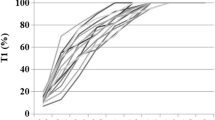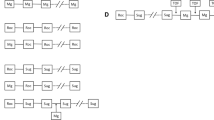Abstract
Purpose
A dose-response relationship study for edrophonium to examine the modification of volatile anaesthetics on reversal of vecuronium block.
Methods
One hundred and twenty ASA (I–II) patients were anaesthetized with sevoflurane, isoflurane (I minimum alveolar anaesthetic concentration [MAC] end-tidal concentration), or fentanyl-diazepam anaesthesia, in combination with 66% nitrous oxide (n = 40 for each group). The evoked electromyogram (EMG) response of the abductor digiti minimi was monitored at 20 sec intervals following train-of-four (TOF) stimulation of the ulnar nerve. The initial neuromuscular block was produced by vecuronium 100 μg · kg−1. When the amplitude of the first response (T1) had spontaneously recovered to 10% of the control, edrophonium (0, 125, 400, 700 or 1000 μg · kg−1; eight patients each) was randomly administered, and the ratio of the fourth TOF to the first response (TOFR ) was monitored at one minute intervals for 10 min.
Results
Sevoflurane and isoflurane impaired the edrophonium-assisted TOFR recovery in an edrophonium dose and time dependent manner. The dose-response curves at 10 min exhibited a greater shift to the right in the sevoflurane and isoflurane groups than in the fentanyl-diazepam-nitrous oxide group (P < 0.05). Higher ED50 values (the edrophonium dose required to obtain TOFR value of 50%) in the sevoflurane (> 1000 μg · kg−1) and isoflurane groups (851 · μg · kg−1) were observed than in the fentanyl-diazepam-nitrous oxide group (339 μg · kg−1) (P < 0.05).
Conclusion
One MAC sevoflurane and isoflurane anaesthesia impair edrophonium reversal of vecuronium block to a similar degree.
Résumé
Objectif
Créer une courbe de relation dose/efet pour l’édrophonium afin étudier les modifications provoquées par les anesthésiques volatils sur l’antagonisme du bloc au vécuronium.
Méthodes
Cent vingt patients ASA I et II étaient anesthésiés avec du sévoflurane, de l’isoflurane (concentration alvéolaire télé-expiratoire minimale [MAC] 1) ou avec fentanyl-diazépam associés au protoxyde 60% (n = 40 par groupe). La réponse électromyographique (EMG) évoquée à l’abducteur du petit doigt était monitorée à des intervalles de 20 sec après stimulation du nerf cubital au train-de-quatre (TOF). Le bloc neuromusculaire initial était produit par du vécuronium 100 μg · kg−1. Aprés la récupération de l’amplitude de la première réponse (T1) à 10% du contrôle, l’édrophonium (0, 125, 400, 700 ou 100 μg · kg−1; huit patients pour chaque dose) était administré aléatoirement et le rapport de la quatrième réponse sur la première du TOF (TOFR) était monitorée à toutes les minutes pour dix min.
Résultats
Le sévoflurane et l’isoflurane ont altéré la récupération assistée par l’édrophonium du TOFR proportionellement au temps et à la dose. Les courbes dose-effet à dix min révélaient une déviation vers la droite des groupes sévoflurane plus marquée que pour le groupe fentanyl-diazépam-protoxyde d’azote (P < 0,05). Dans les groupes sévoflurane (> 1000 μg · kg−1) et isoflurane (851 μg · kg−1), des valeurs ED50 (tes doses d’édrophonium requises pour obtenir un TOFR de 50%) plus élevées ont été observées que dans le groupe fentanyl-diazépam-protoxyde d’azote (339 μg · kg−1; P < 0,05).
Conclusion
À MAC 1, le sévoflurane et l’isoflurane entrave au même degré l’antagonisme par l’édrophonium du bloc produit par le vécuronium.
Similar content being viewed by others
References
Delisle S, Bevan DR. Impaired neostigmine antagonism of pancuronium during enflurane anaesthesia in man. Br J Anaesth 1982; 54: 441–5.
Dernovoi B, Agoston S, Barvais L, Baurain M, Lefebvre R, d’Hollander A. Neostigmine antagonism of vecuronium paralysis during fentanyl, halothane, isoflurane, and enflu rane anesthesia. Anesthesiology 1987; 66: 698–701.
Baurain MJ, d’Hollander AA, Melot C, Dernovoi BS, Barvais L. Effects of residual concentrations of isoflurane on the reversal of vecuronium-induced neuromuscular blockade. Anesthesiology 1991; 74: 474–8.
Lee C, Tsai S-K, Kwan W-K, Chen B-J, Cheng ML. Desflurane potentiates atracurium in humans: a compara tive study with isoflurane. J Clin Anesth 1992; 4: 448–54.
Morita T, Tsukagoshi H, Sugaya T, Saito S, Sato H, Fujita T. Inadequate antagonism of vecuronium-induced neuro muscular block by neostigmine during sevoflurane or isoflurane anesthesia. Anesth Analg 1995; 80: 1175–80.
Smith CE, Donati F, Bevan DR. Dose-response relation ships for edrophonium and neostigmine as antagonists of atracurium and vecuronium neuromuscular blockade. Anesthesiology 1989; 71: 37–43.
Kopman AK. Recovery times following edrophonium and neostigmine reversal of pancuronium, atracurium, and vecuronium steady-state infusions. Anesthesiology 1986; 65: 572–8.
Wachtel RE. Comparison of anticholinesterases and their effects on acctylcholine-activated ion channels. Anesthesiology 1990; 72: 496–503.
Gill SS, Bevan DR, Donati F. Edrophonium antagonism of atracurium during enflurane anaesthesia. Br J Anaesth 1990; 64: 300–5.
Cronnelly R, Morris RB, Miller RD. Edrophonium: dura tion of action and atropine requirement in humans during halothane anesthesia. Anesthesiology 1982; 57: 261–6.
Katoh T, Suguro Y, Kimura T, Ikeda K. Cerebral awaken ing concentration of sevoflurane and isoflurane predicted during slow and fast alveolar washout. Anesth Analg 1993; 77: 1012–7.
Cannon JE, Fahey MR, Castagnoli KP, et al. Continuous infusion of vecuronium: the effect of anesthetic agents. Anesthesiology 1987; 67: 503–6.
Morita T, Tsukagoshi H, Sugaya T, Yoshikawa D, Fujita T. The effects sevoflurane are similar to those of isoflurane on the neuromuscular block produced by vecuronium. Br J Anaesth 1994; 72: 465–7.
Tai K, Suzuki H, Itagaki T, et al. Influence of sevoflurane on neuromuscular blocking effects of vecuronium and pancuronium. (Japanese) Masui 1987; 36: 227–32.
Yost CS, Maestrone E. Clinical concentrations of edropho nium enhance desensitization of the nicotinic acetylcholine receptor. Anesth Analg 1994; 78: 520–6.
Brett RS, Dilger JP, Yland KF. Isoflurane causes “flicker ing” of the acetylcholine receptor channel: observations using the patch clamp. Anesthesiology 1988; 69: 161–70.
Kopman AF. Tactile evaluation of train-of-four count as an indicator of reliability of antagonism of vecuronium- or atracurium-induced neuromuscular blockade. Anesthesio logy 1991; 75: 588–93.
Salib YM, Donati F, Bevan DR. Edrophonium antagonism of vecuronium at varying degrees of fourth twitch recov ery. Can J Anaesth 1993; 40: 839–43.
Beemer GH, Goonetilleke PH, Bjorksten AR. The maxi mum depth of an atracurium neuromuscular block antago nized by edrophonium to effect adequate recovery. Anesthesiology 1995; 82: 852–8
Author information
Authors and Affiliations
Corresponding author
Rights and permissions
About this article
Cite this article
Morita, T., Kurosaki, D., Tsukagoshi, H. et al. Sevoflurane and isoflurane impair edrophonium reversal of vecuronium-induced neuromuscular block. Can J Anaesth 43, 799–805 (1996). https://doi.org/10.1007/BF03013032
Accepted:
Published:
Issue Date:
DOI: https://doi.org/10.1007/BF03013032




